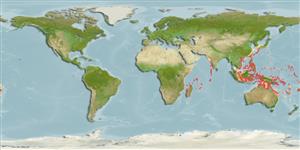Teleostei (teleosts) >
Gobiiformes (Gobies) >
Trichonotidae (Sanddivers)
Etymology: Trichonotus: Greek, thrix = hair + Greek, noton = back (Ref. 45335).
Environment: milieu / climate zone / depth range / distribution range
Ecology
Marine; reef-associated; depth range 2 - 40 m (Ref. 90102). Subtropical
Indo-West Pacific: Maldive Islands to Micronesia and Fiji, north to Ryukyu Islands.
Size / Weight / Age
Maturity: Lm ? range ? - ? cm
Max length : 18.0 cm SL male/unsexed; (Ref. 559)
Found in coastal reef slopes and deep outer reef lagoons in current channels. Usually in large groups with several large males (Ref. 48636). Inhabits sand-rubble bottoms (Ref. 90102). Found hovering above sandy slopes. Usually forms a harem of one male-phase fish and about a dozen female-phase fish (Ref. 37240). Normally buried when no current is running (Ref. 48636).
Life cycle and mating behavior
Maturity | Reproduction | Spawning | Eggs | Fecundity | Larvae
Shimada, K. and T. Yoshino, 1984. A new trichonotid fish from the Yaeyama Islands, Okinawa Prefecture, Japan. Jap. J. Ichthyol. 31(1):15-22. (Ref. 37240)
IUCN Red List Status (Ref. 130435)
Threat to humans
Harmless
Human uses
More information
Common namesSynonymsMetabolismPredatorsEcotoxicologyReproductionMaturitySpawningSpawning aggregationFecundityEggsEgg development
ReferencesAquacultureAquaculture profileStrainsGeneticsElectrophoresesHeritabilityDiseasesProcessingNutrientsMass conversion
Tools
Special reports
Download XML
Internet sources
Estimates based on models
Preferred temperature (Ref.
123201): 24.6 - 28.8, mean 27.4 °C (based on 184 cells).
Phylogenetic diversity index (Ref.
82804): PD
50 = 0.5020 [Uniqueness, from 0.5 = low to 2.0 = high].
Bayesian length-weight: a=0.00389 (0.00180 - 0.00842), b=3.12 (2.94 - 3.30), in cm total length, based on all LWR estimates for this body shape (Ref.
93245).
Trophic level (Ref.
69278): 3.5 ±0.5 se; based on size and trophs of closest relatives
Fishing Vulnerability (Ref.
59153): Low vulnerability (12 of 100).
